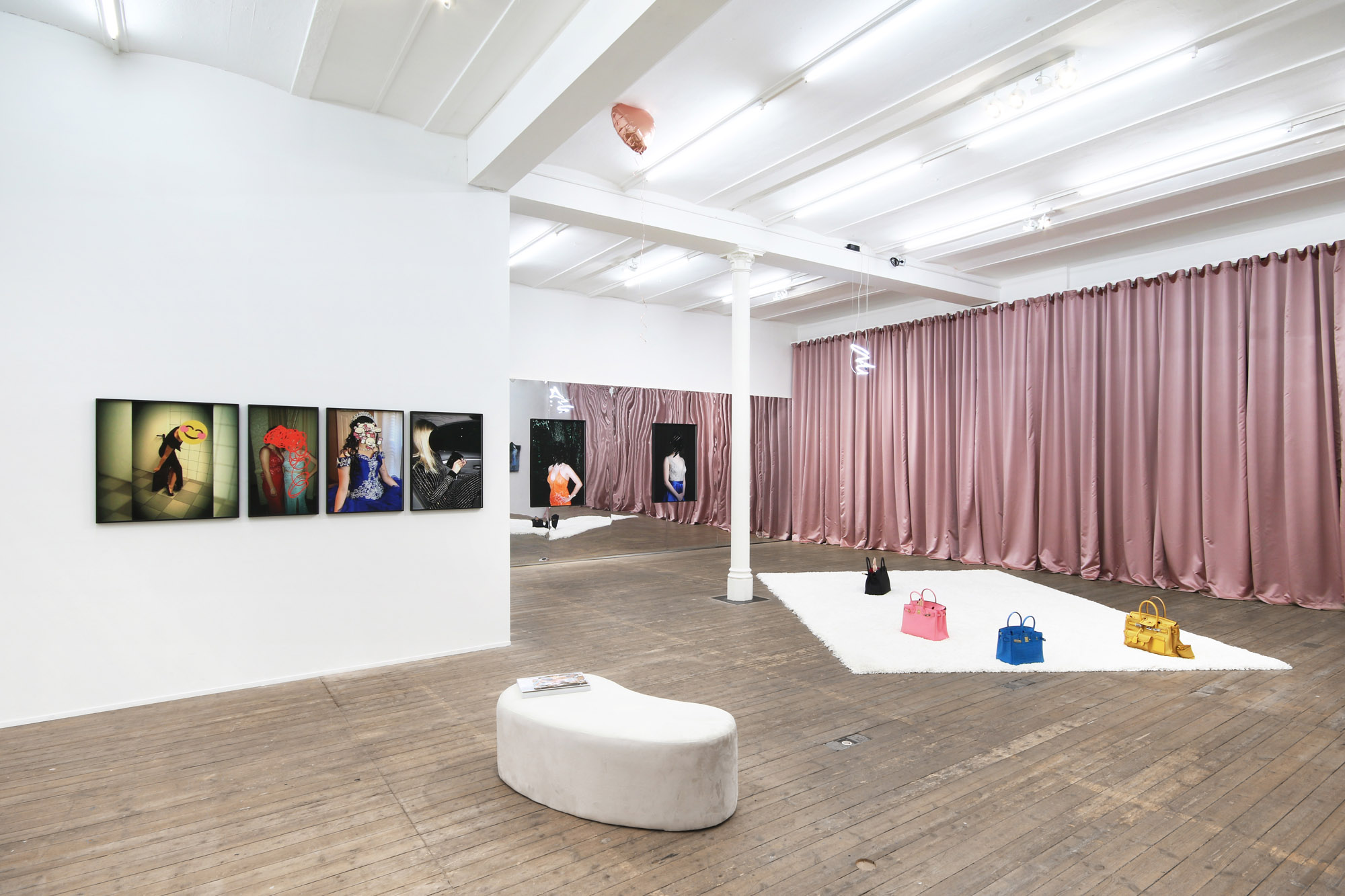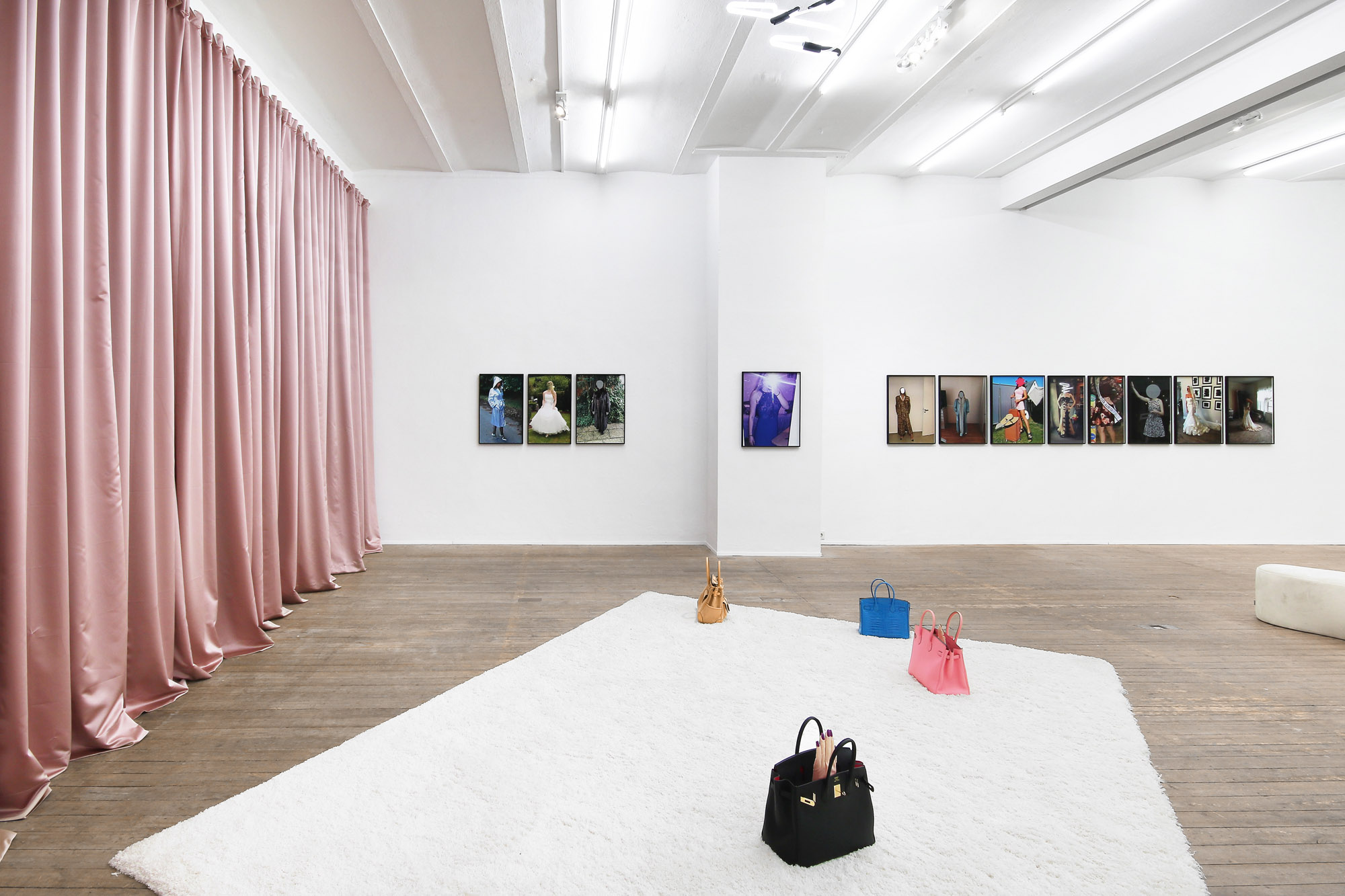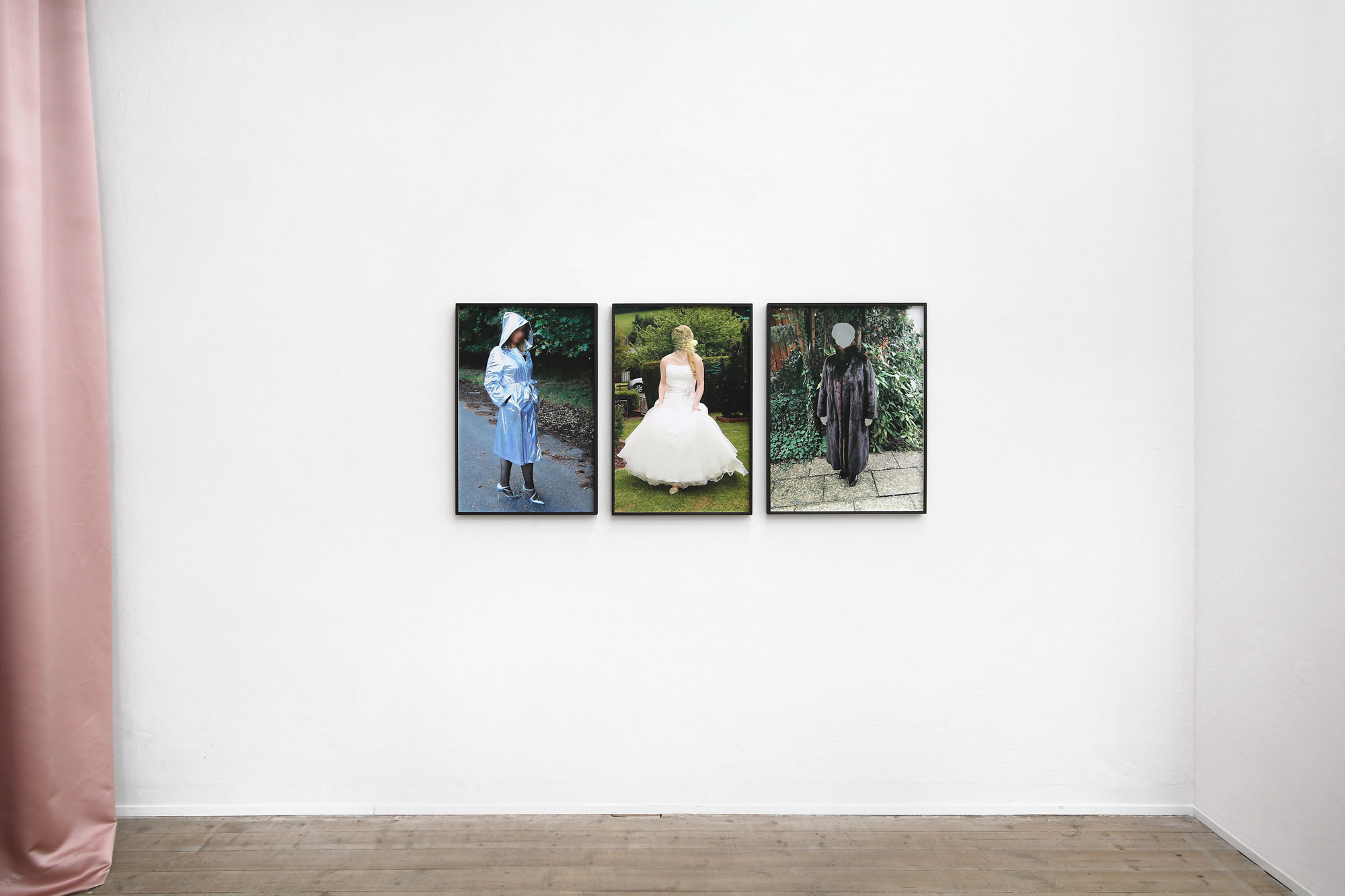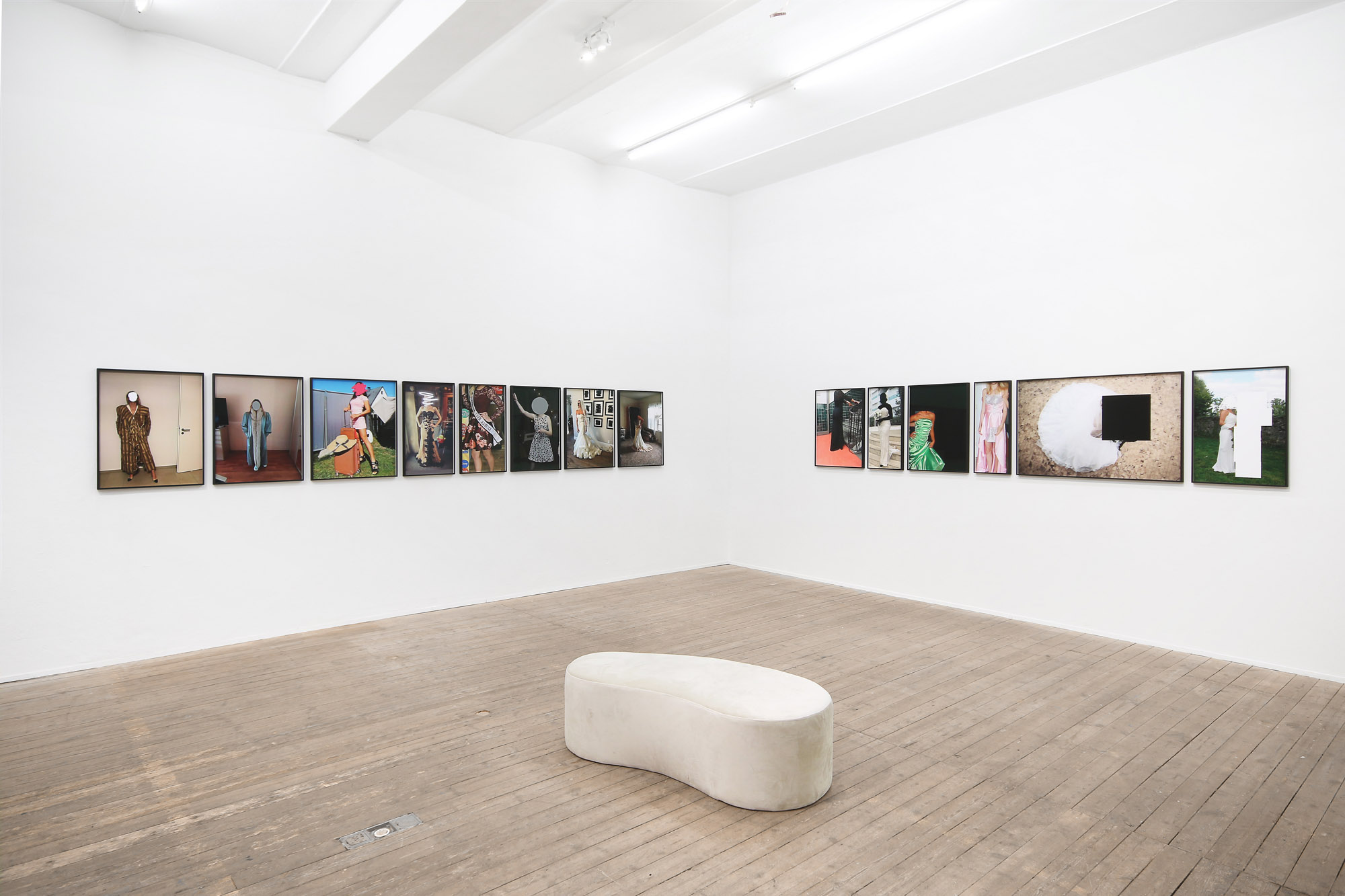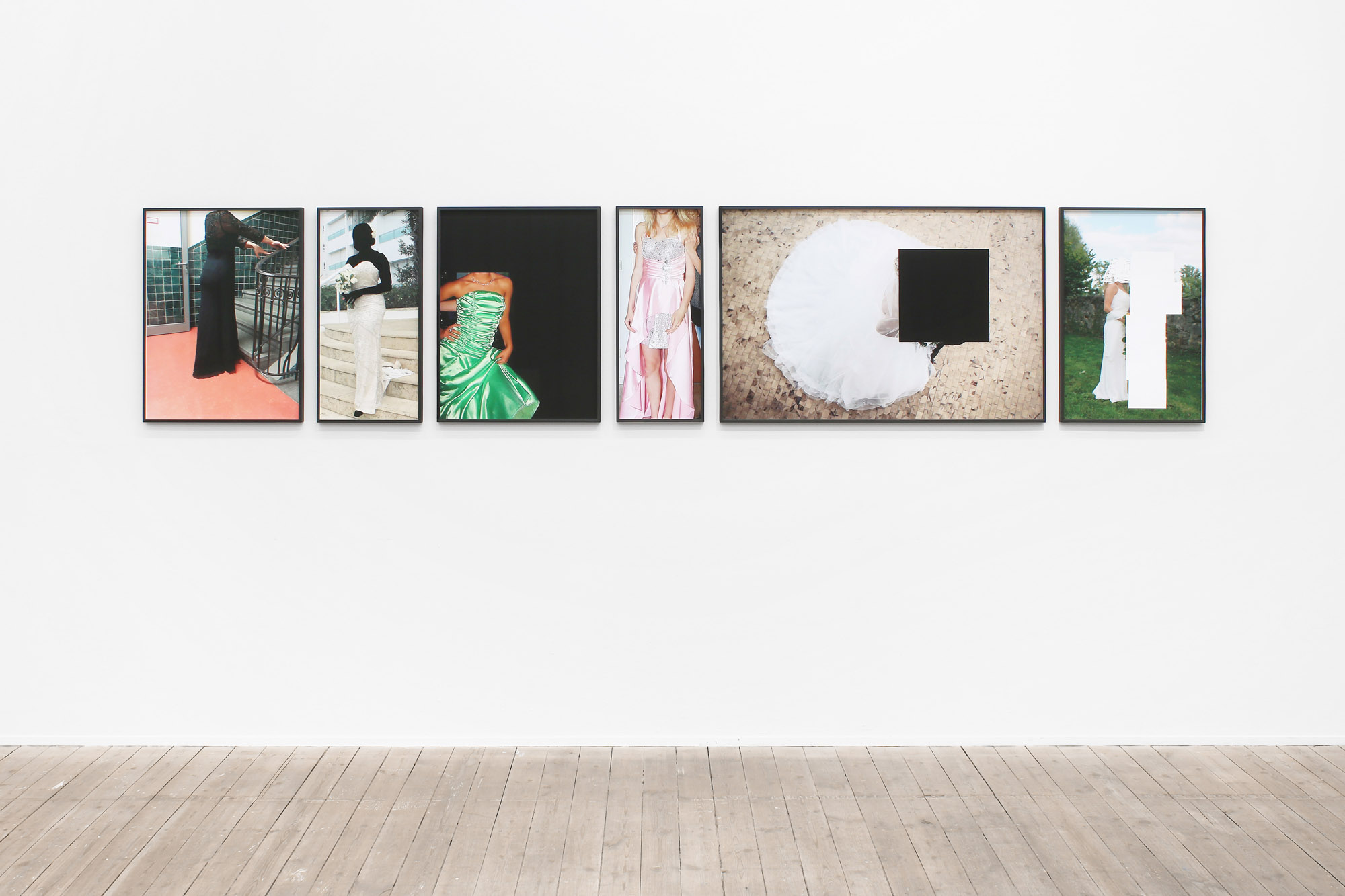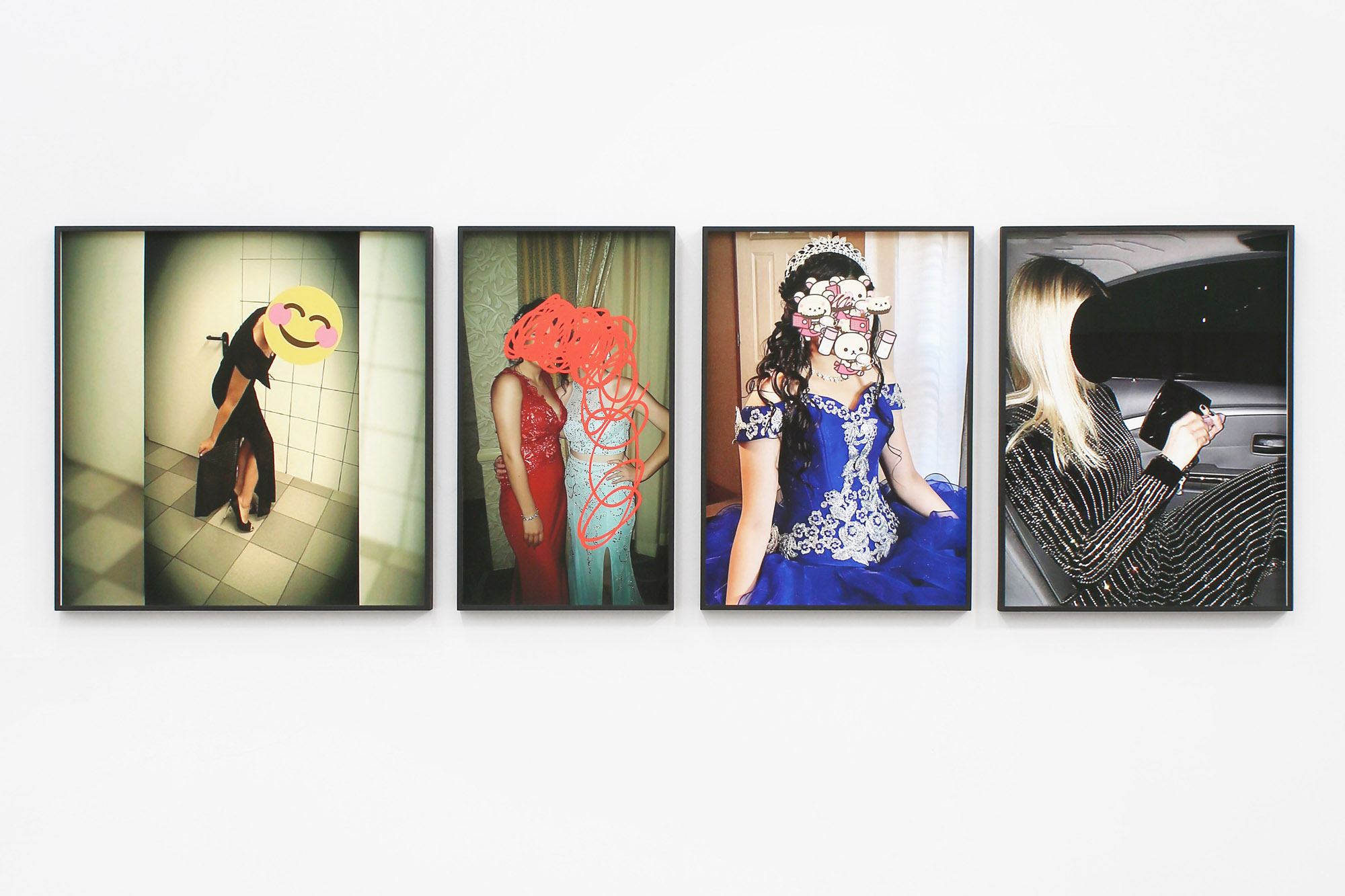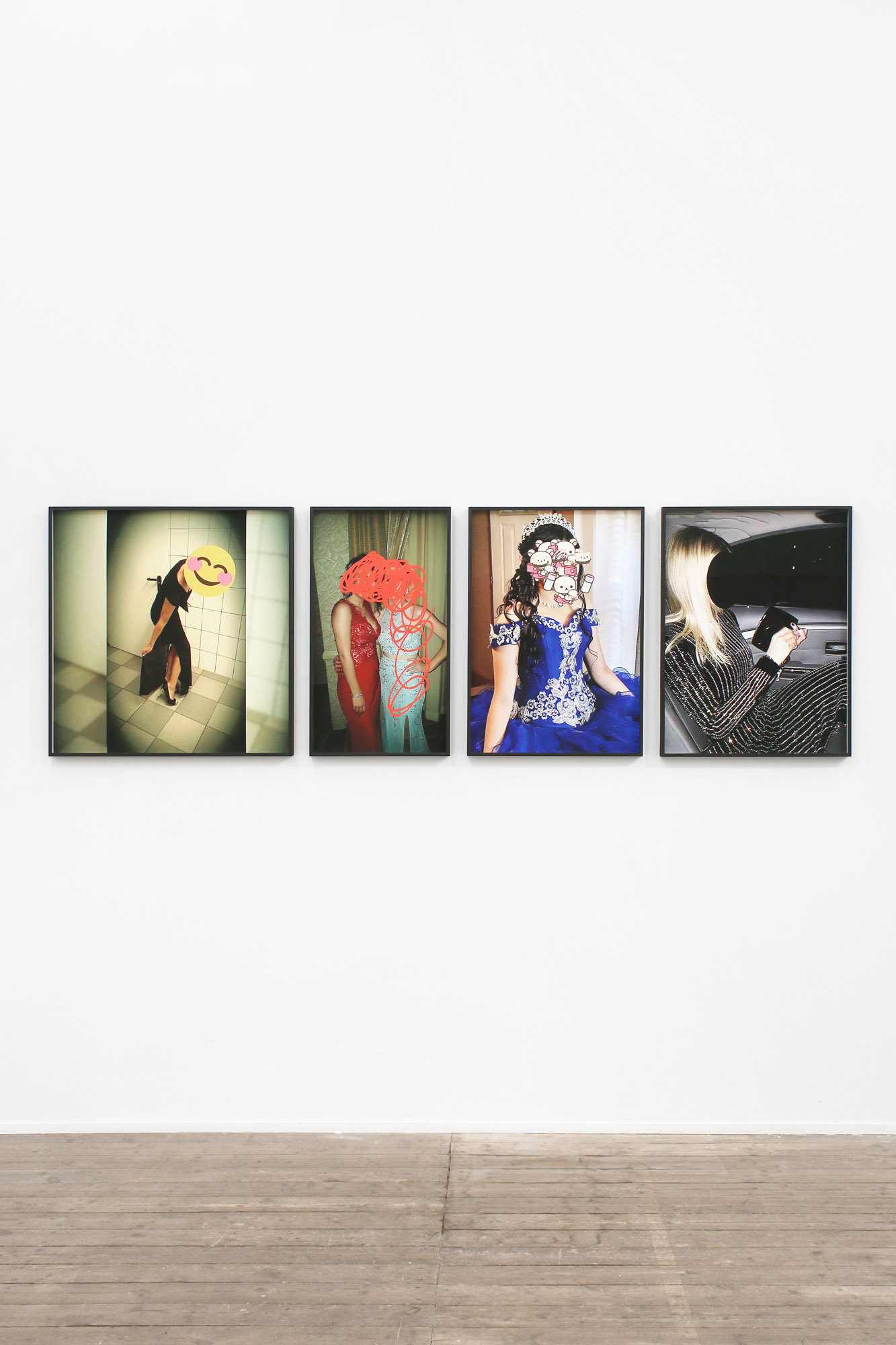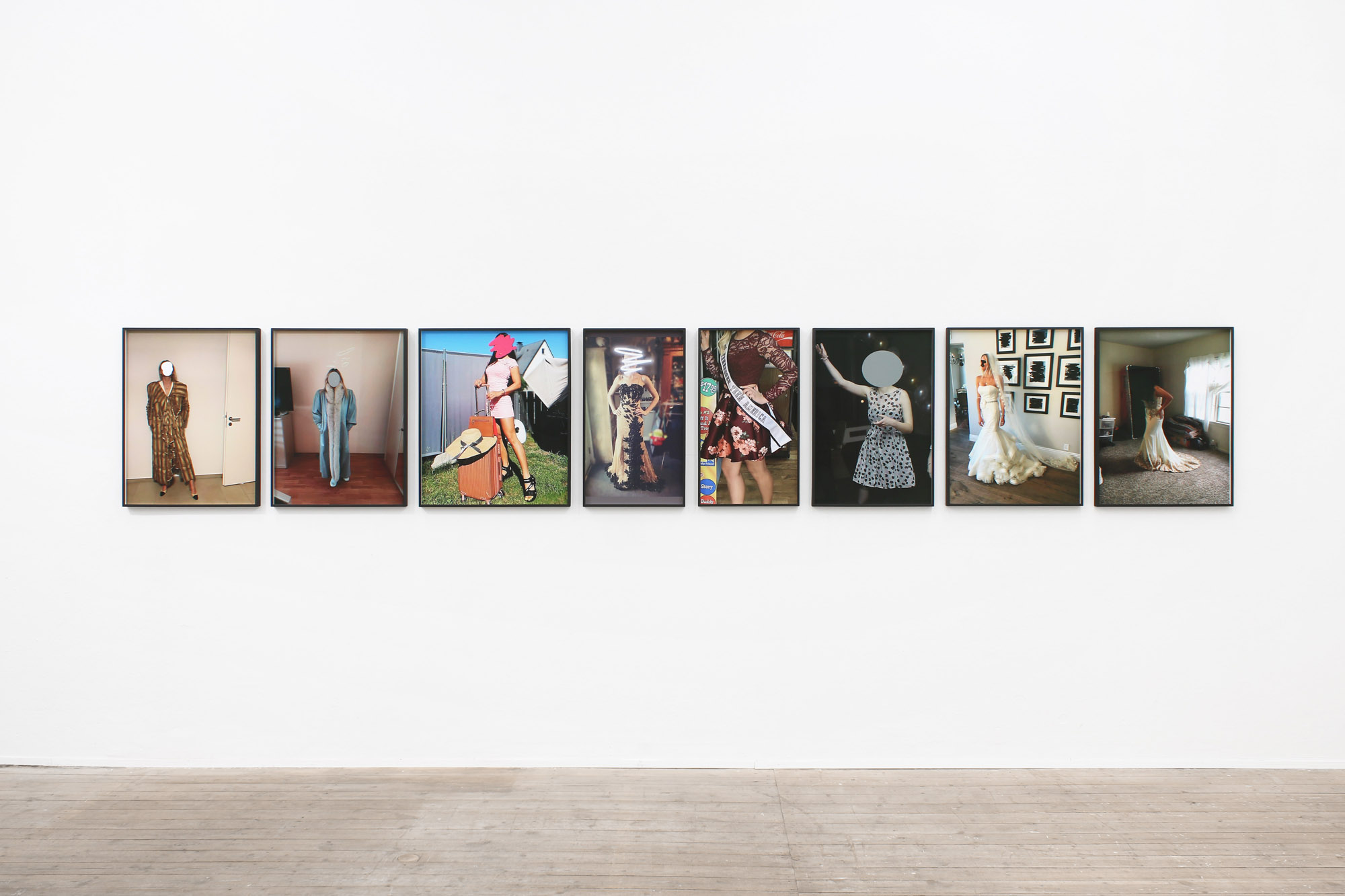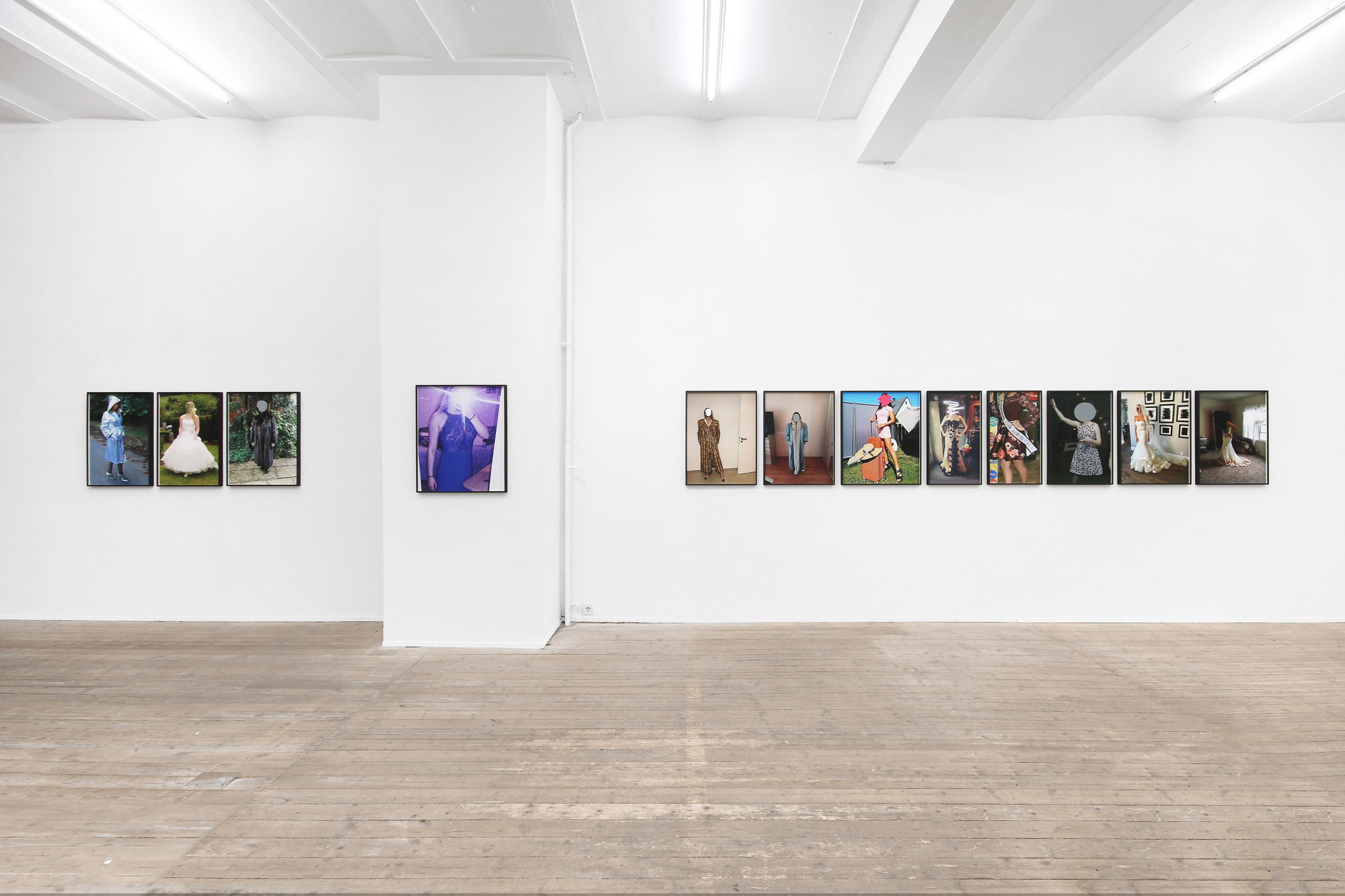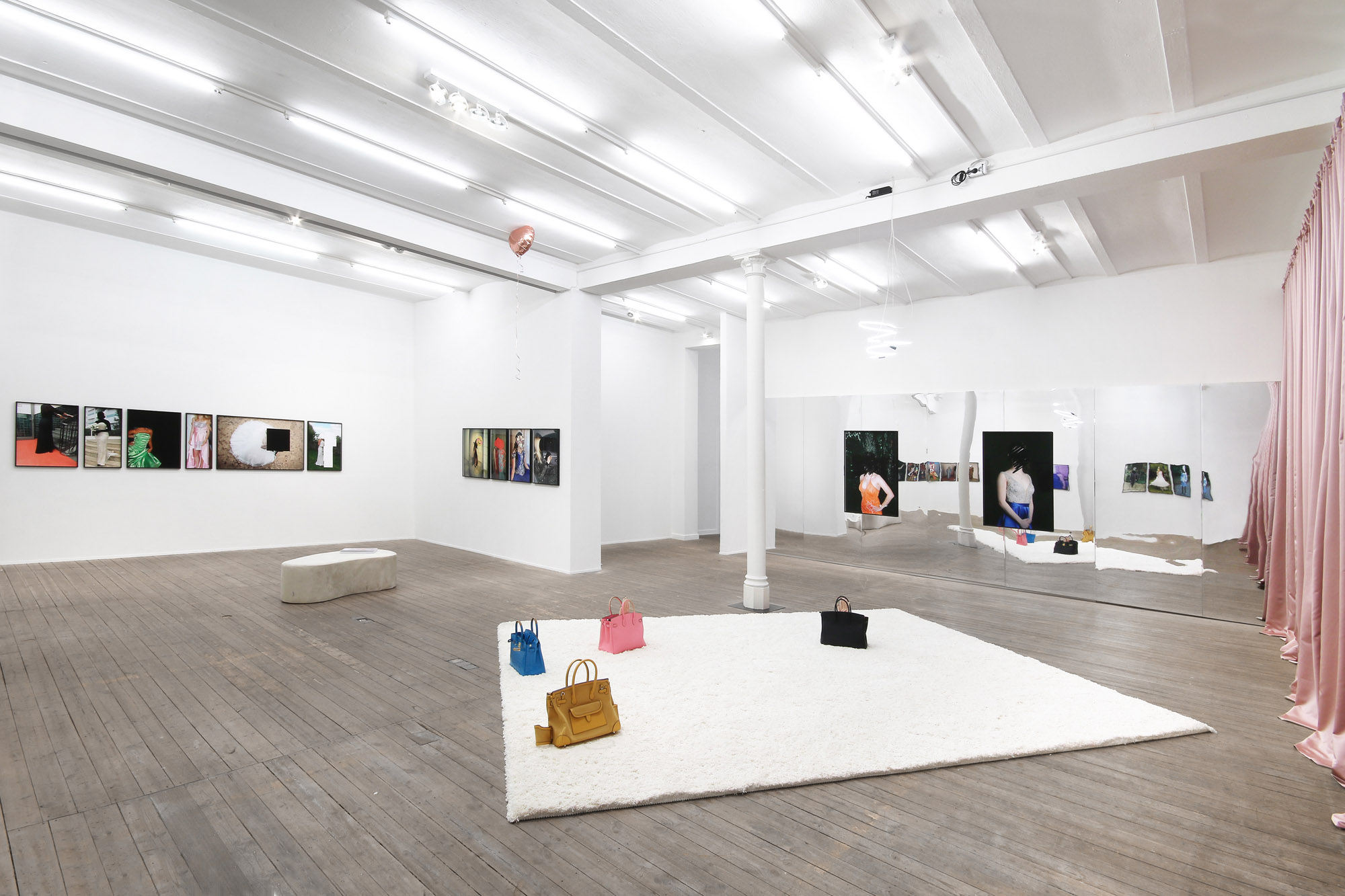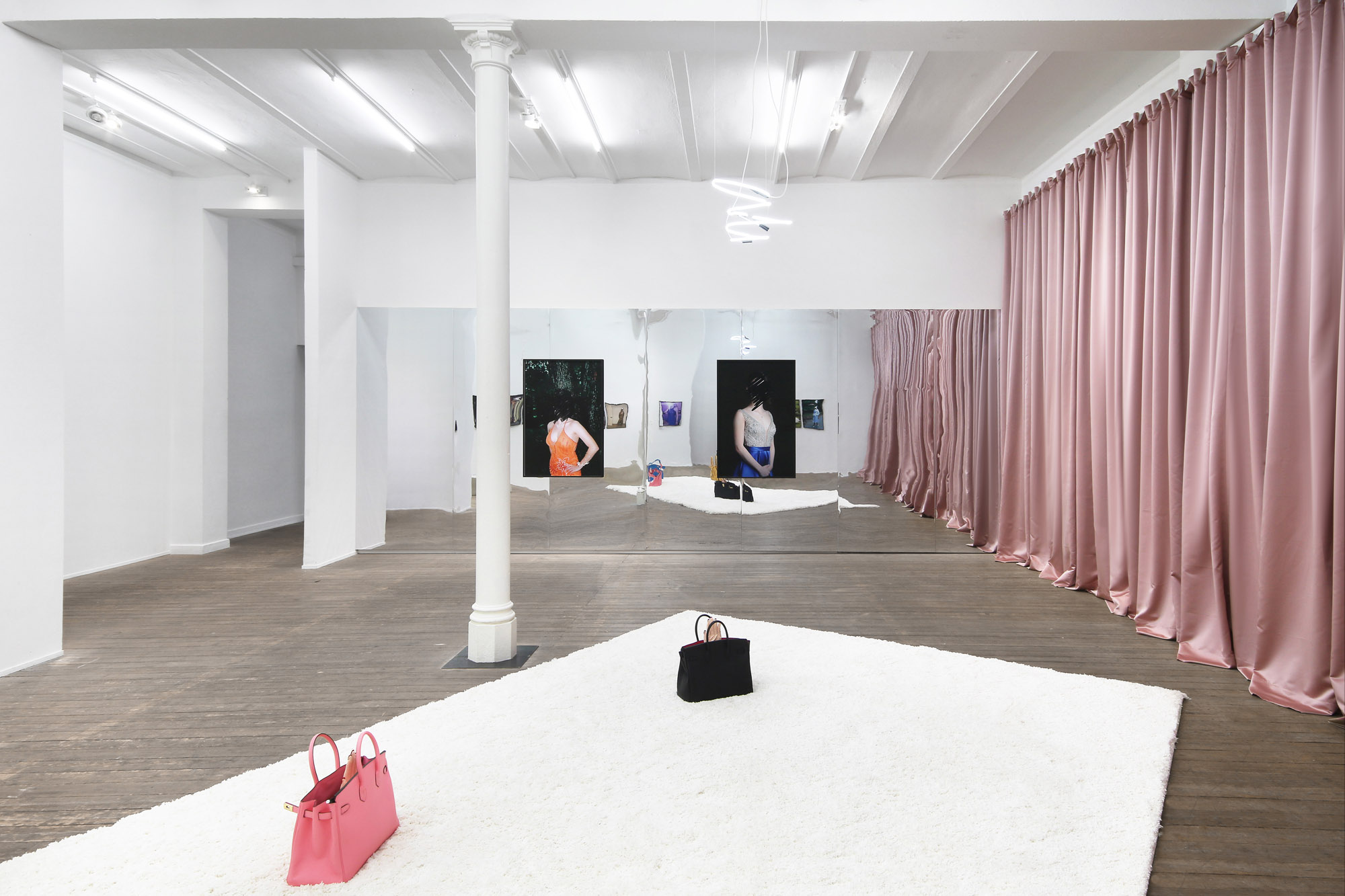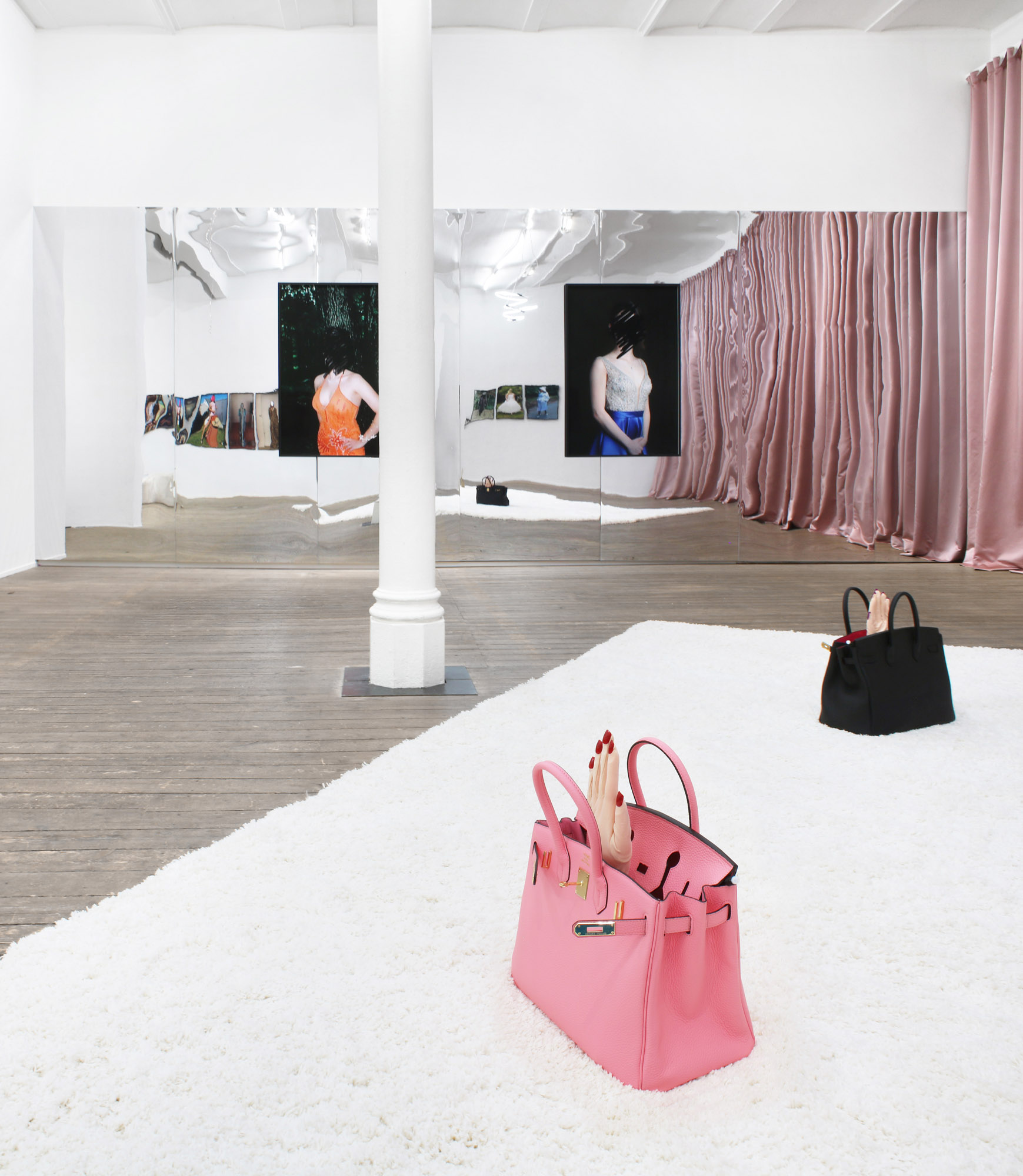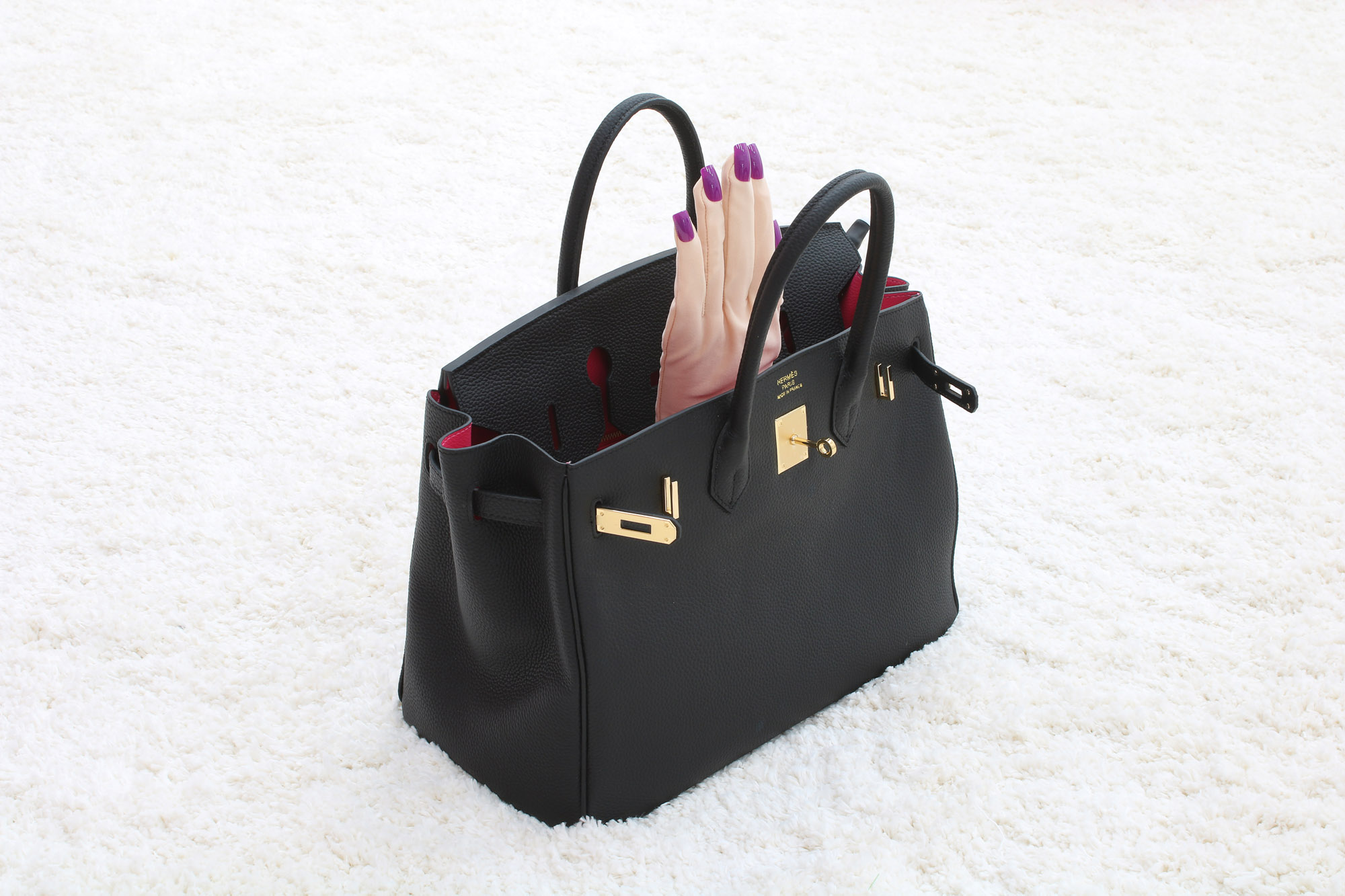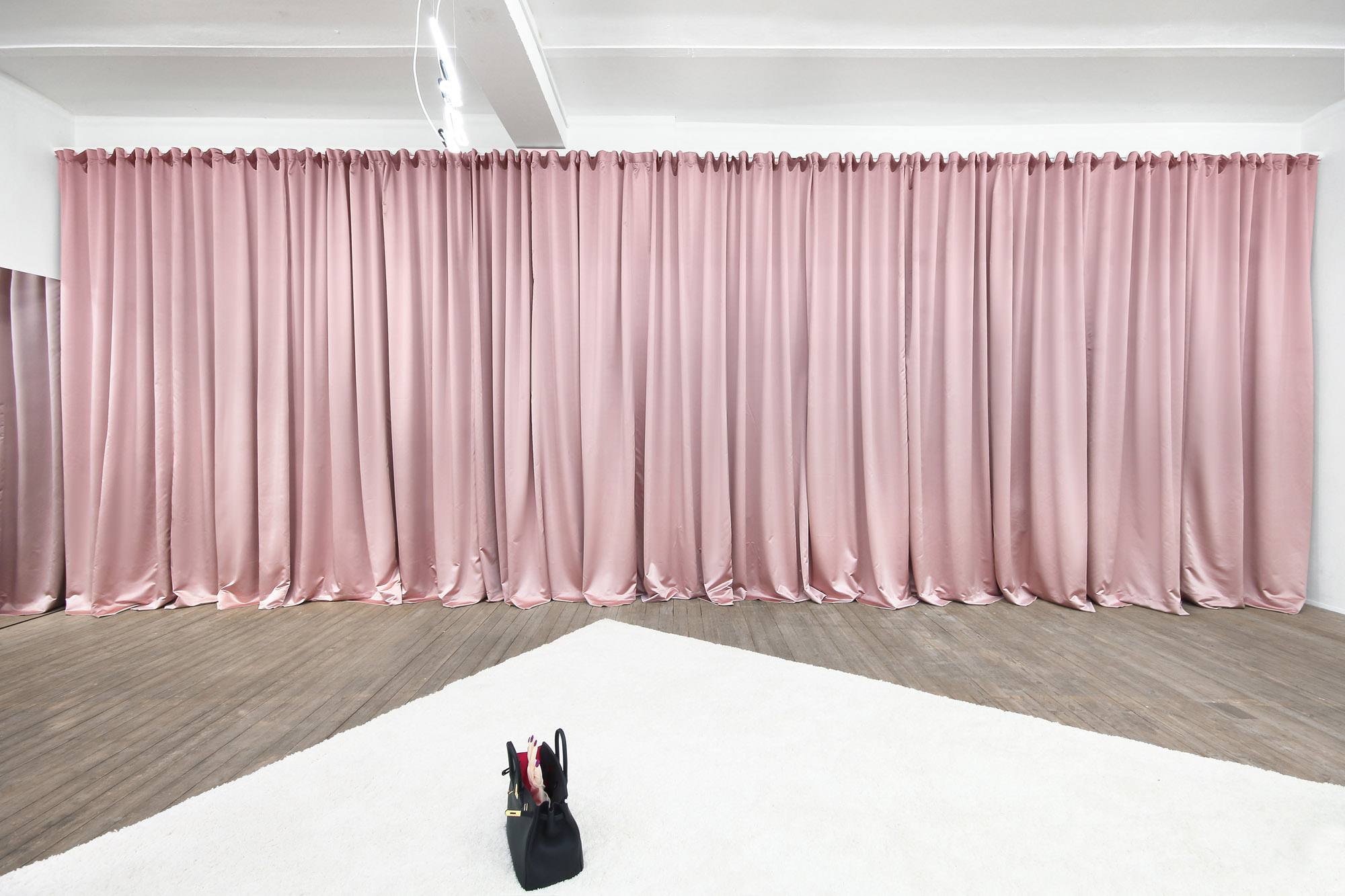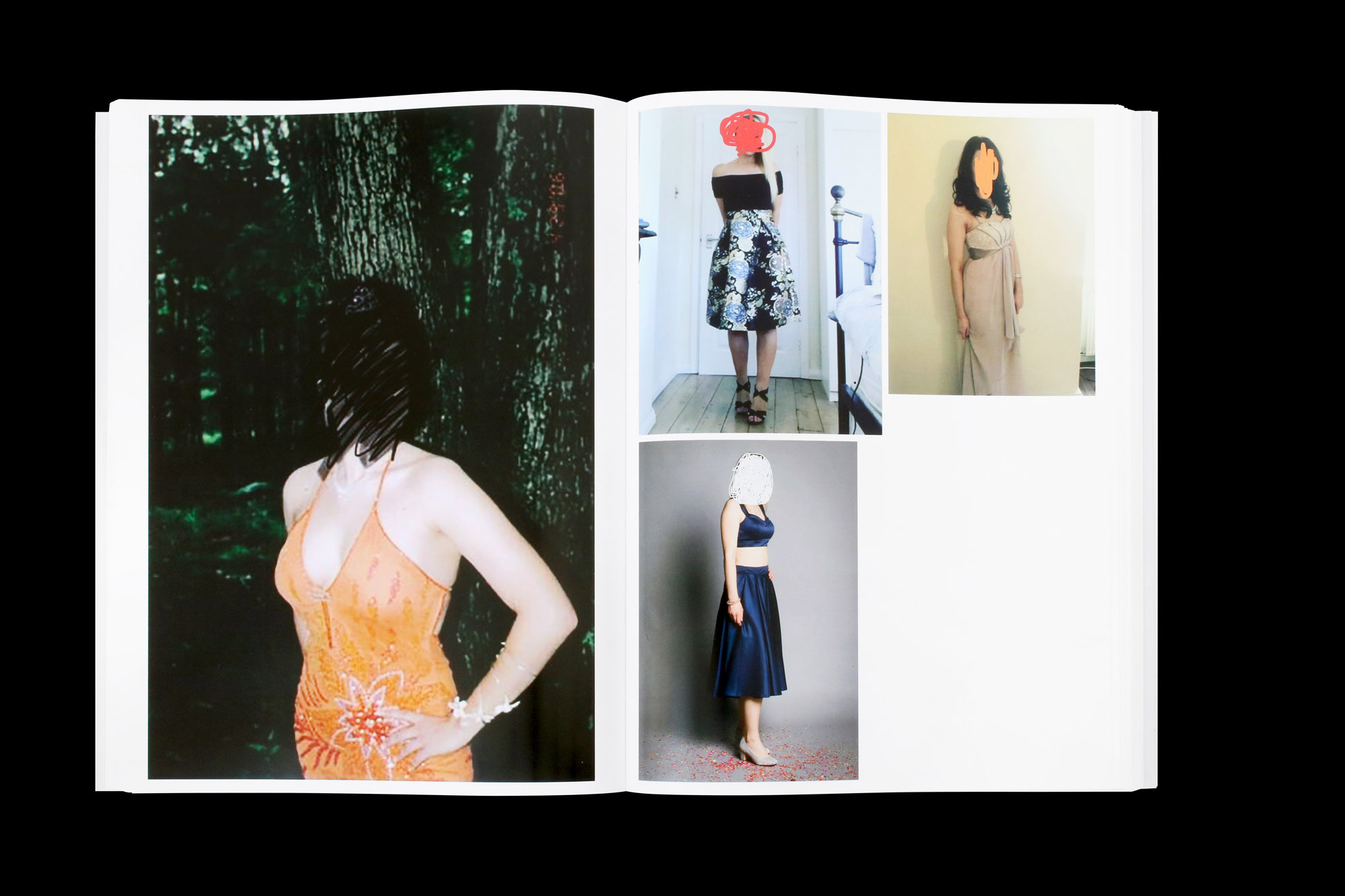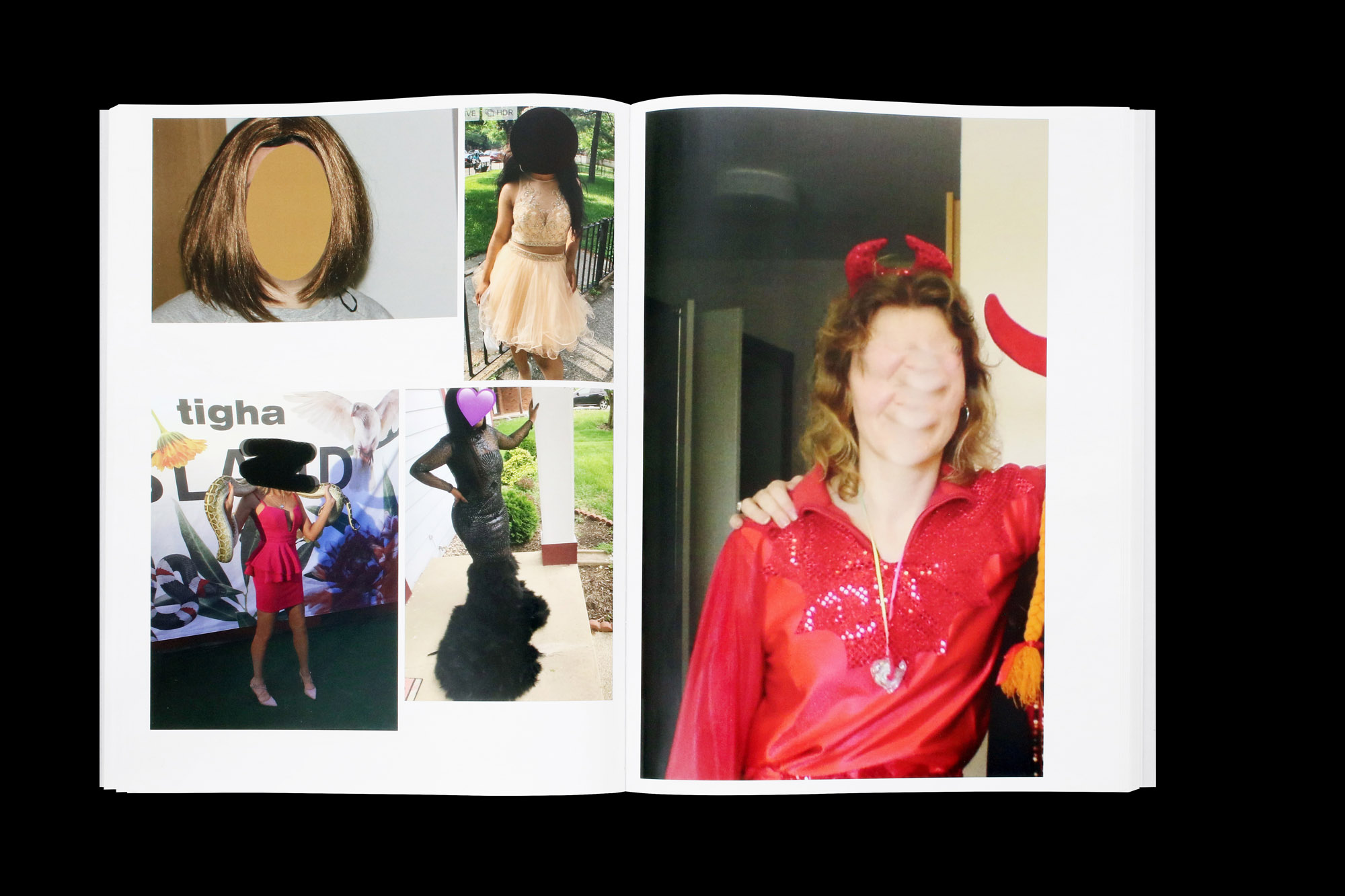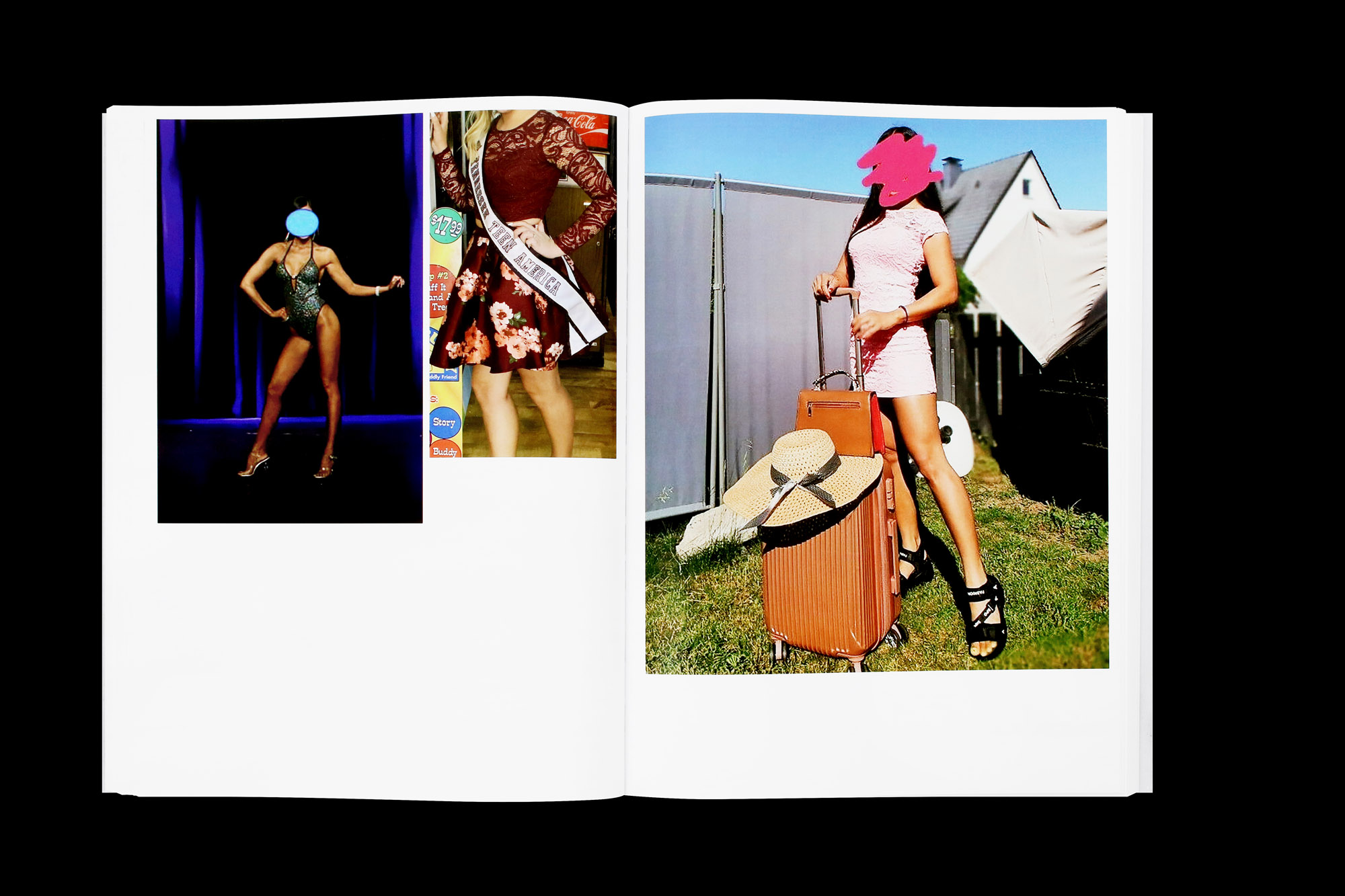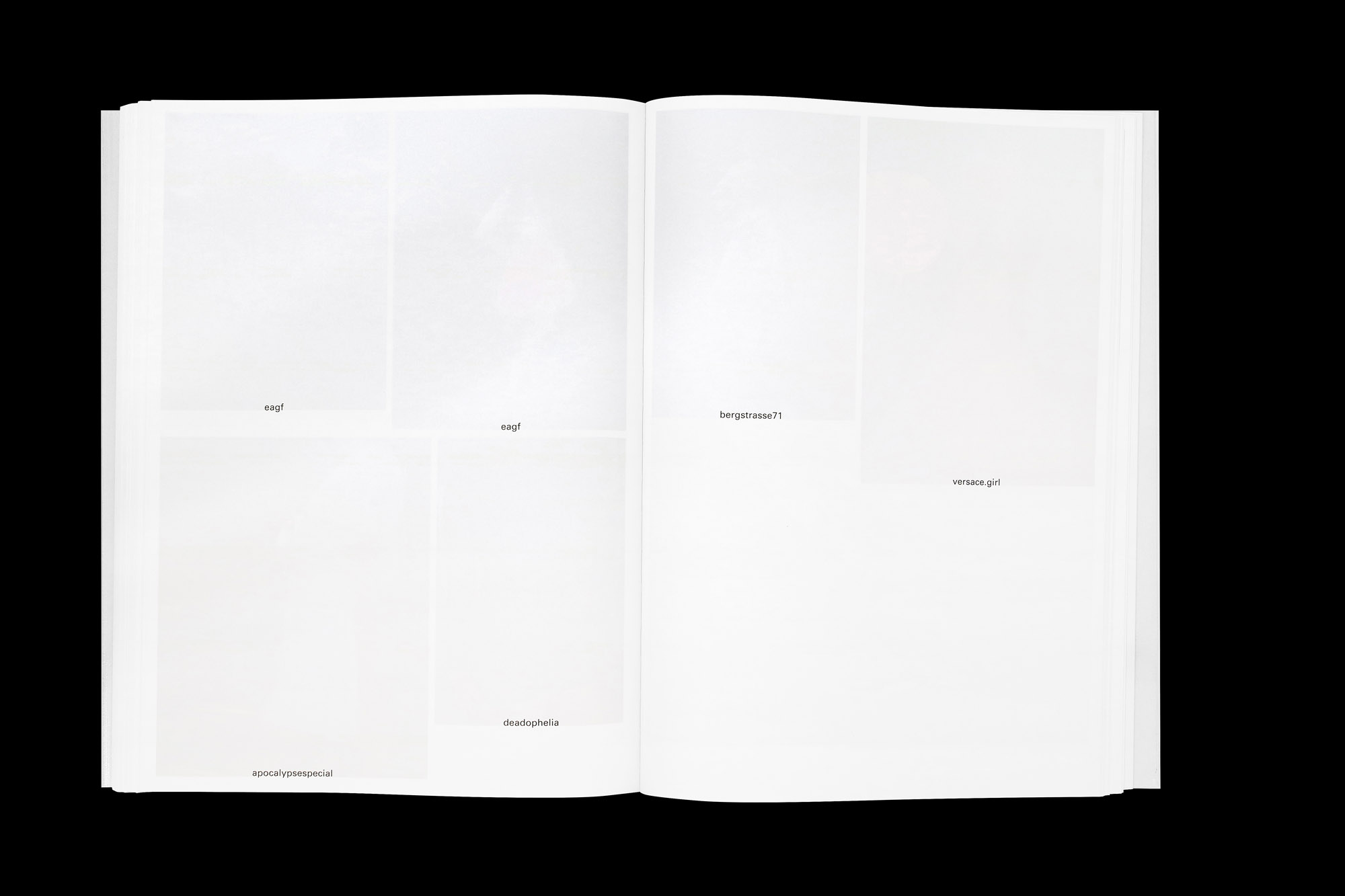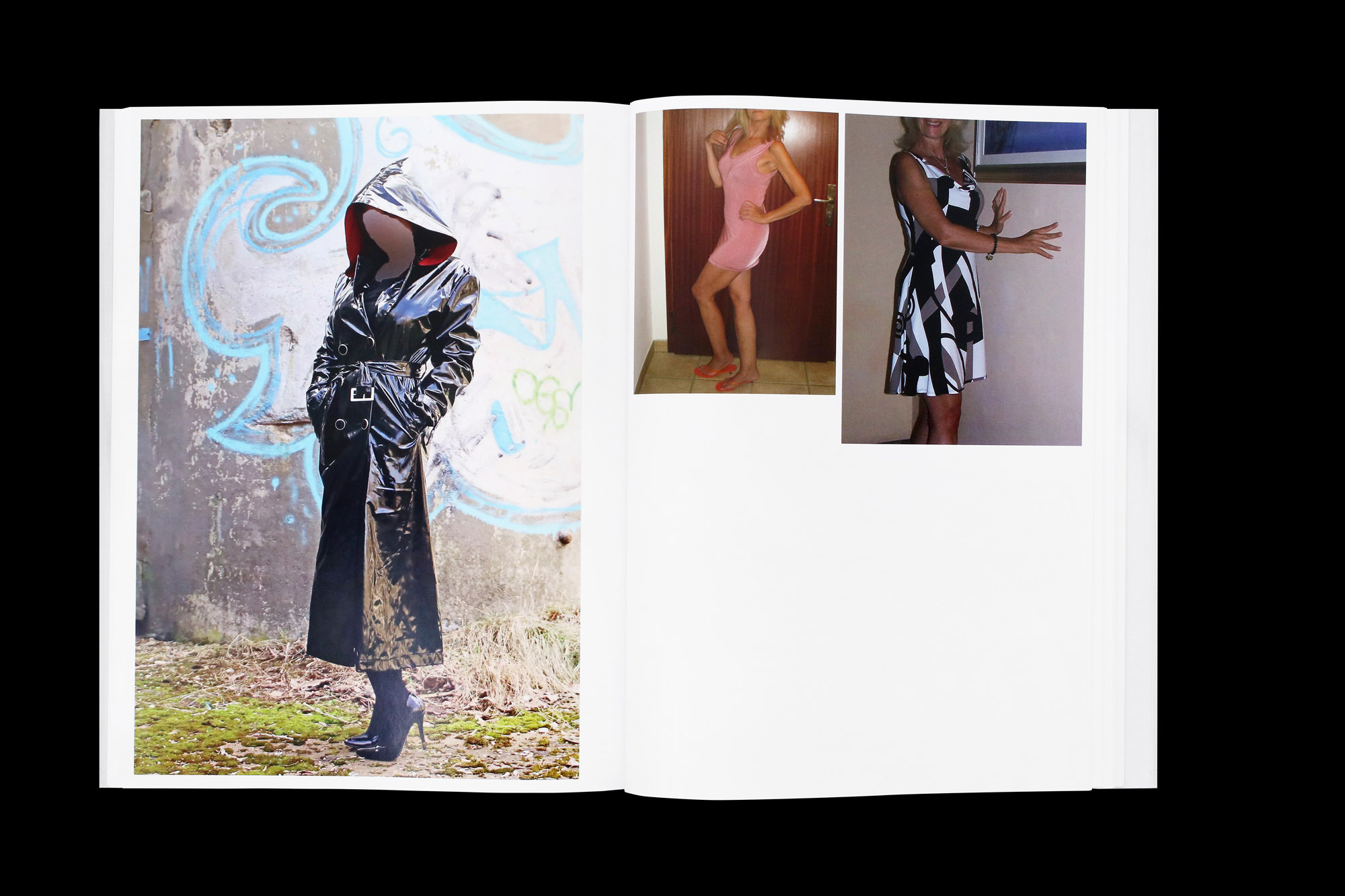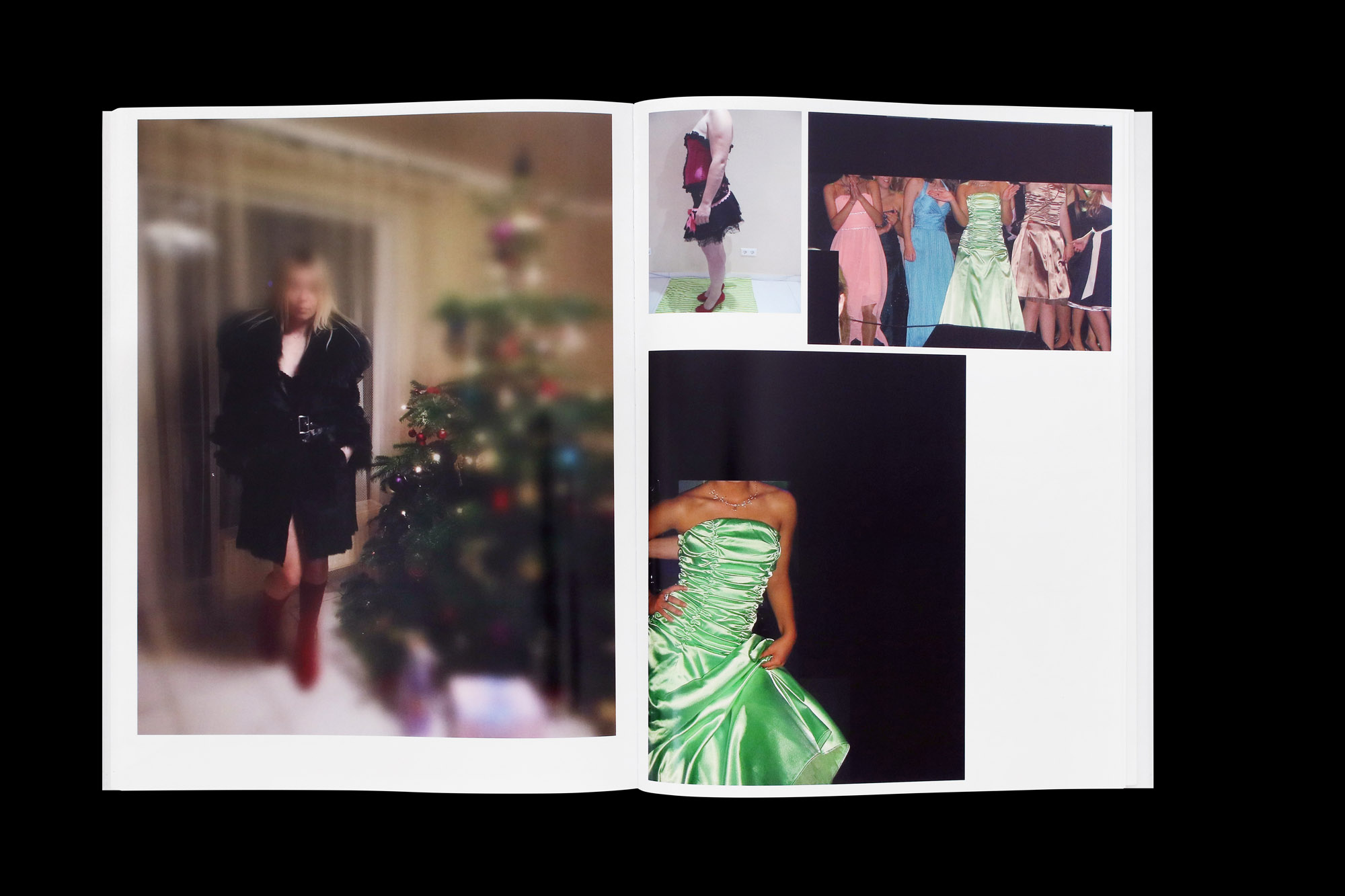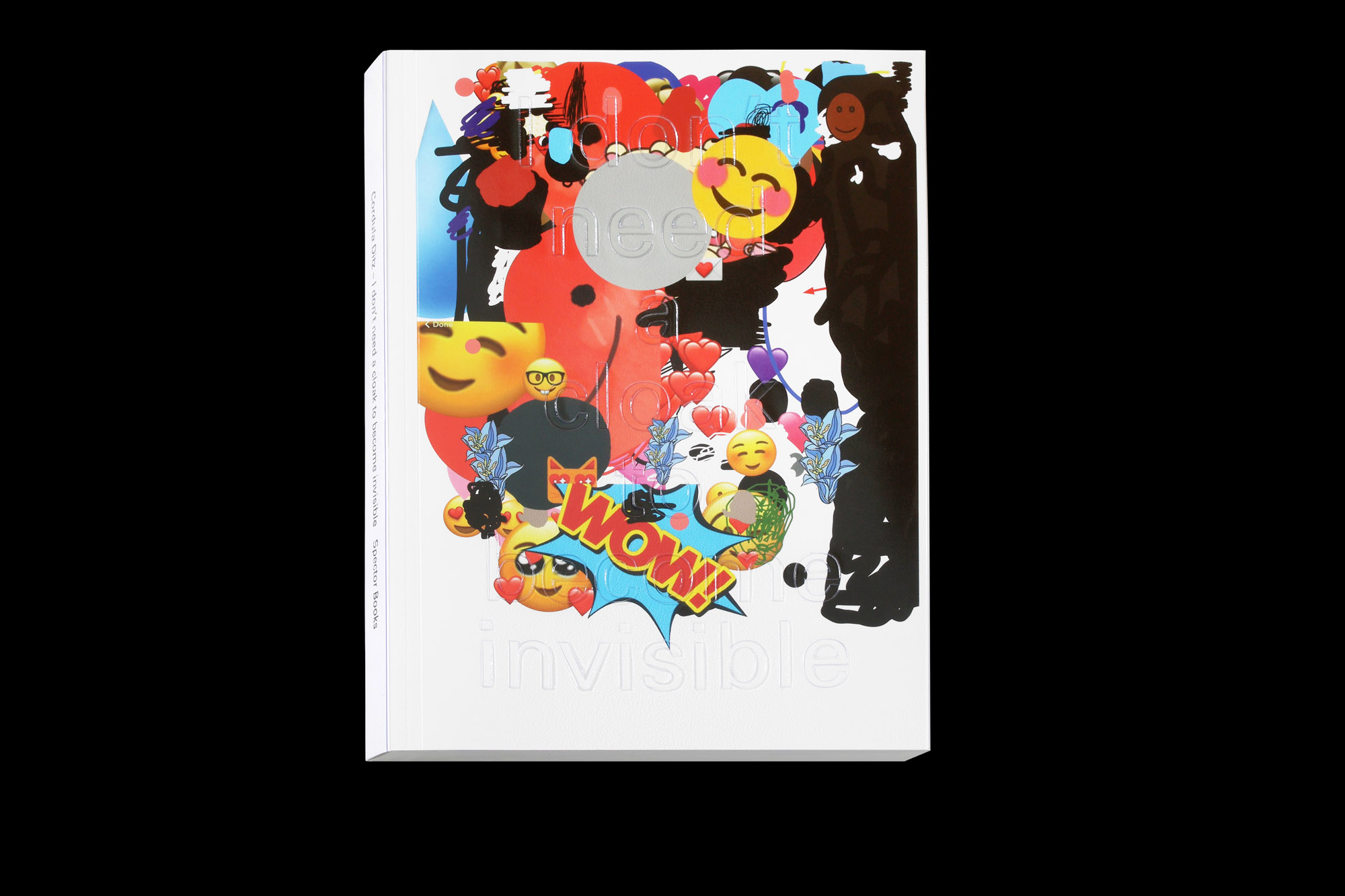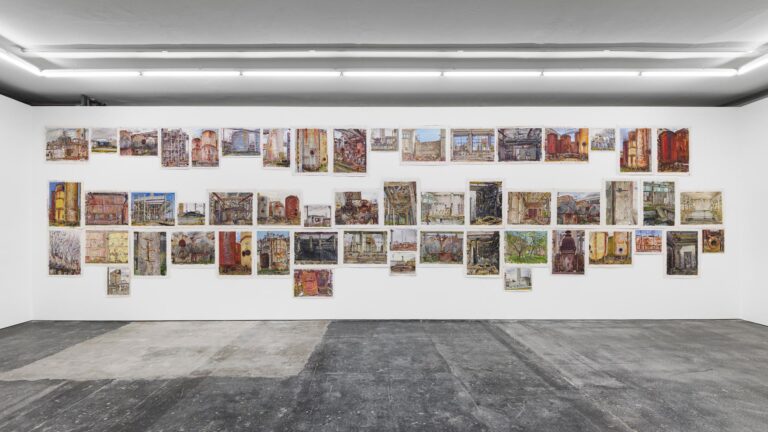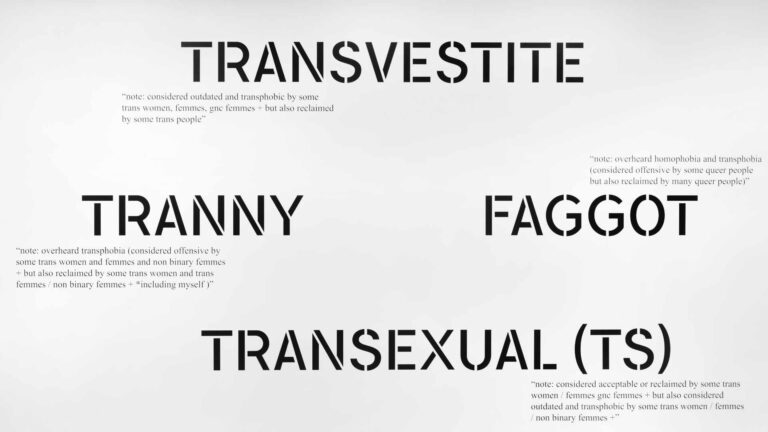Artist: Cordula Ditz
Exhibition title: I don’t need a cloak to become invisible
Venue: Galerie Conradi, Hamburg, Germany
Date: September 9 – December 10, 2022
Photography: all images copyright and courtesy of the artist and Galerie Conradi, Hamburg
Cordula Ditz’s newest research publication, I don’t need a cloak to become invisible, brings together over four hundred images selected from the online selling platform eBay. Nearly all are selfies taken by women or photographs of women, who offer what they wear for sale while disguising their faces. The artist transfers images gleaned from online listings from across Germany and the United States into printed matter in form of an artist book.
In its pages, Ditz assembles the found images into collages, that in layout and size come close to that of glossy fashion magazines. The compositions range from the size of a smartphone screen to an entire page. Views of the same clothes from the front, side and back are displayed alongside one another – referencing the way in which a potential buyer may first have encountered the various items for sale, ordered by a swiping tool. By drawing attention to these images in toto, removed from their original context, Ditz’s project approaches a case study of female visibility online. Flicking through the book, a production quirk compresses its illustrated pages, revealing only white pages that are almost blank save for small black captions – the names of the women’s eBay profiles. Usernames like osterhasie, powerpaddy2000, leather poet71327 create a layer of information, offering insights into a seller’s socio -economic background and online identity that precedes their image. It embodies the first choice of individuation, and sets a base of identity that goes beyond depiction.
In the vast space of online selling platforms, on first glance these women become invisible, part of a mass movement playing into the economics of selling, image politics and gender roles. With their faces disguised, the viewer’s gaze naturally moves to the bodies captured by the seller’s camera. The posture and poses of the women portrayed often echo traditional body language and body norms. One leg is placed over the other, an arm rests on the hip with a lightly twisted torso, many choose a now-ubiquitous tilted stance, one leg standing and the other leaning.
This popular contrapose was also identified by artist Marianne Wex. In her visual survey, Let’s take back our space: “Female” and “Male” Body Language as a Result of Patriarchal Structures (1979), Wex gathered around 2,500 to 3,000 images of the body language of men and women, as seen in the streets of Hamburg, and in television and commercials, which she then categorized according to a kind of body language topology. Most of the conscious posing is influenced by the omnipresence of media imagery: Wex’s project reveals how our body language is a direct reference to the power relations at stake in our everyday lives – the power relations of gender.[1] Photographing the women in the street puts forward the status-quo in black and white – women waiting at the bus stop, sitting on a park bench or in a room with other people. Once placed next to each other, the restrictive and one-dimensional body language of crossed legs, folded arms and a general tightness of the body become visible. Only when women are amongst other women does their body language relax; they are in not consciously chosen positions with wider stances and loose arms.
In contrast, the reality that Ditz brings together is one of digital culture. Through the means of the artist book, one is immersed in the private reality of selling online – already used goods are offered up on its pages, bringing together only a small excerpt of the seemingly never-ending image flow prevalent on online selling platforms. Here, the creation of an identity has become deeply saturated by the media aesthetic. Nonetheless, a similar dynamic of body language is at play as in Wex’s study. With the intention to highlight the clothes in a promotional way, most of the poses chosen by the women reinforce the patriarchal stereotypes of body language. In this way, the codes documented by Marianne Wex are still present, the main perpetrator and receiver is still male – there is no breaking down of these frameworks. By extension, all of these images are in one sense aimed at the male gaze – yet hold it at a distance.
Alongside professional photos of weddings, portraits or themed photo-shoots, a great volume of the photographs depicted here are selfies.
As Mary McGill writes in her essay on the female gaze and selfie culture, “Rather than viewing [selfies] as a missed opportunity to flout convention, it is perhaps more productive to consider how this apparent conformity speaks to the power and complicated pleasures of women’s relationship to images of the feminine, including images of themselves”.[2] Indeed, it might be said that the women gathered together by Ditz are aware of the constructed nature of feminine imagery, and the object-hood of the female body. In turn, they appropriate its protocols and act from a position of power, using tools once-aimed at the male gaze to their mercantile advantage. Coded poses and constructions of femininity are here created for the female or nonbinary gaze of potential buyers.
Ditz’s artist book extends this phenomenon further, using images in which the faces of the women are disguised to disrupt the power dynamic of the gaze. The methods by which this is achieved are similar but specific, and range from scribbled-over paint in an assortment of colors, to emojis, flowers and the use of blurring tools to render faces unrecognizable. Here, the quickening of anonymity becomes visible. Besides their own faces, in rare cases other people in the photos are crossed out in black ink. In one image, a woman posed in front of the Eiffel Tower covers her face with a pink bow and another person with a big heart.
In this way, the time taken not only to pose but also to edit these images renders the level of engagement, computer and internet skills as well as intent comprehensible to the viewer. The decisions driving image-selection range from hyper-intentional to random, rendering the women the independent authors of their own making – tracing the inheritance of the invisible. Furthermore, the scribbling out or choice of Emoji can be read as depictions of various attitudes and emotions towards each woman’s own body. With the self removed, then, the act of disguising one’s face counteracts the urge to become famous or recognizable – an inversion of the creation of a desirable online identity or influencer model. In most of the selected images, the backgrounds remain untouched or edited by the users, giving a view into an individual’s social context and private lives – staged in scenes from changing rooms to bedrooms and driveways. The spectator is invited into the immediate realities of the women – their homes, weddings or even fetishes are shared. At the same time, some women even create more extraordinary surroundings, to show off their items and their bodies in a more attractive light. A dress is presented in the front seat of an expensive car, a decorated staircase and a glass of champagne are turned into the backdrop for a wedding dress, or furniture or props are used to support a specific fantasy.
The title, I don’t need a cloak to become invisible is taken from a scene in the first Harry Potter book. Whilst roaming the corridors of Hogwarts late at night – thanks to a coat that makes him invisible – Harry Potter discovers a miraculous mirror. Gazing into the depths of the Mirror of Erised, as it is known, its glass surface makes visible what you most desire. By the mirror’s own special charms, one may only see their own longing – and yet the headmaster Dumbledore, who suddenly appears, seems to know all those portrayed desires, stating: “I don’t need a cloak to become invisible.”[3]
Even though the women shown by Ditz disguise their faces, in some images their desires seem to become visible through staged imagery and representative scenography. The women often use mediatized and gendered conventions to portray publicly available versions of themselves.
Ditz’s survey attests to a paradox: through the act of anonymization, an individual’s desires and attitudes become more visible. In this way, I don’t need a cloak to become invisible offers a counterimage of women online, who utilize the act of quickened anonymity as a reappropriation of the self.
Text: Paula Kommoss
[1] Marianne Wex, „Weibliche“ und „männliche“ Körpersprache als Folge patriarchalischer Machtverhältnisse, Hamburg 1980.
[2] Mary McGill, ‘How the Light Gets In: Notes on the female gaze and selfie culture’, MAI: Feminism & Visual Culture, published 1 May 2018, https://maifeminism.com/how-the-light-gets-in-notes-on-the-female-gaze-and-selfie-culture/ accessed 22 July 2022.
[3] J.K. Rowling, Harry Potter and the Philosopher’s Stone, London 1997, ch. The Mirror of Erised.
Cordula Ditz, I don’t need a cloak to become invisible, exhibition view, Galerie Conradi, 2022
Cordula Ditz, I don’t need a cloak to become invisible, exhibition view, Galerie Conradi, 2022
Cordula Ditz, I don’t need a cloak to become invisible, exhibition view, Galerie Conradi, 2022
Cordula Ditz, I don’t need a cloak to become invisible, exhibition view, Galerie Conradi, 2022
Cordula Ditz, I don’t need a cloak to become invisible, exhibition view, Galerie Conradi, 2022
Cordula Ditz, I don’t need a cloak to become invisible, exhibition view, Galerie Conradi, 2022
Cordula Ditz, detail from the series I don’t need a cloak to become invisible, from left to right: Untitled (ehundsieh1), Untitled (annabelreblit_0), Untitled (djmbtoday), Fine Art Prints, Galerie Conradi, 2022
Cordula Ditz, detail from the series I don’t need a cloak to become invisible, Fine Art Prints, Galerie Conradi, 2022
Cordula Ditz, detail from the series I don’t need a cloak to become invisible, from left to right: Untitled (topsecret1110), Untitled (justaspiffyfrenzy), Untitled (image00014), Untitled (bianc-rossm), Fine Art Prints, Galerie Conradi, 2022
Cordula Ditz, detail from the series I don’t need a cloak to become invisible, from left to right: Untitled (topsecret1110), Untitled (justaspiffyfrenzy), Untitled (image00014), Untitled (bianc-rossm), Fine Art Prints, Galerie Conradi, 2022
Cordula Ditz, detail from the series I don’t need a cloak to become invisible, Fine Art Prints, Galerie Conradi, 2022
Cordula Ditz, I don’t need a cloak to become invisible, exhibition view, Galerie Conradi, 2022
Cordula Ditz, I don’t need a cloak to become invisible, exhibition view, Galerie Conradi, 2022
Cordula Ditz, I don’t need a cloak to become invisible, exhibition view, Galerie Conradi, 2022
Cordula Ditz, I don’t need a cloak to become invisible, exhibition view, Galerie Conradi, 2022
Cordula Ditz, I don’t need a cloak to become invisible, exhibition view, Galerie Conradi, 2022
Cordula Ditz, detail from the series I don’t need a cloak to become invisible, left: Untitled (lacar-4474), right: Untitled (kyber81), Fine Art Prints, 2022, Untitled (Innocence), Fake mirror wall, dimensions vary with installation, Galerie Conradi, 2022
Cordula Ditz, I don’t need a cloak to become invisible, exhibition view, Galerie Conradi, 2022
Cordula Ditz, Untitled (breathless), 2022, Mixed media, glove with purple nails in bag, motion
Cordula Ditz, Untitled (Lover), 2022, Mixed media, glove with red nails in bag, motion, Cordula Ditz, Untitled (friend), 2022, Mixed media, eyes in bag
Cordula Ditz, Untitled (pink shadow), 2022, Curtains in dusty pink party satin, dimensions vary with installation, Cordula Ditz, Untitled (breathless), 2022, Mixed media, glove with purple nails in bag, motion
Cordula Ditz, I don’t need a cloak to become invisible, Spector Books, 2022
Cordula Ditz, I don’t need a cloak to become invisible, Spector Books, 2022
Cordula Ditz, I don’t need a cloak to become invisible, Spector Books, 2022
Cordula Ditz, I don’t need a cloak to become invisible, Spector Books, 2022
Cordula Ditz, I don’t need a cloak to become invisible, Spector Books, 2022
Cordula Ditz, I don’t need a cloak to become invisible, Spector Books, 2022
Cordula Ditz, I don’t need a cloak to become invisible, Spector Books, 2022



